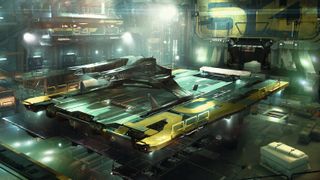Inside Squadron 42: Star Citizen's ambitious singleplayer campaign

This article was originally published in PC Gamer issue 286. For more quality articles about all things PC gaming, you can subscribe now in the UK and the US.
When I first heard about Squadron 42, Star Citizen’s FPS campaign, I was expecting Call of Duty in space. A parade of cinematic set-pieces with an all-star cast and a handful of linear missions. The appetiser to Star Citizen’s main course. But as I spoke to the talented team developing it—Wilmslow-based Foundry 42—it became clear that they’re attempting something far more ambitious. Lead level designer Mike Barclay, whose previous work includes the Crysis series, tells me about Squadron 42’s design philosophy. He cites games such as Thief and Deus Ex—particularly the way their freeform design encourages creative play—as a big inspiration. Foundry 42 wants the FPS component of Star Citizen to mirror the open-ended, player-driven design of its space sandbox.
Barclay loads up a level to give me an example. We’re in space, and I see a station orbiting a colossal gas giant. Taking control of the camera, he flies us towards the station, and we transfer seamlessly inside. Suddenly, with no loading breaks, we’re in an FPS level. This smooth transition from space to detailed interiors is an important part of Squadron 42, which lets you both fly ships and travel on foot.
We pull back out into space, and Barclay explains his open-ended approach to mission design. He considers the game’s levels as being more like multiplayer maps than linear mazes that the player is funnelled through. He spins the camera around the base, showing me several different entry points, some stealthy, some noisy.
There’s a landing pad, but if I land the enemies guarding the station will see me and go into high alert. Which is fine, if I want an action experience. If I want to avoid combat, I can get close enough to avoid their scanners, eject from my ship, float over, and slip quietly into an airlock. That’s just two examples, but Barclay says every level will offer multiple ways to enter, exit, and complete objectives.

If you cause a ruckus, enemies will call in reinforcements, but they won’t magically appear from what Barclay calls a ‘monster closet’. They’ll be nearby, in ships, and will fly in to help. But if you manage to sneak onto the base quietly, you might be able to take over its AA guns and blast that backup out of the sky, leaving the base helpless as you begin your assault. This kind of systemic design is what defines some of the best games on PC, and it’s encouraging to see Foundry 42 embracing it here.
Squadron 42 will take place in a small area of Star Citizen’s overall galaxy—but that’s ‘small’ in a galactic sense. It’s a massive chunk of space, and, the team promises, completely open. They say you’ll be able to fly freely between stations and star systems, pursuing both the main story and secondary, optional missions. As Barclay gives me a tour of the level I can see markers on the vast starfield behind it, indicating distant worlds. This is to make moving around such an enormous space a lot easier for the developers.
PC Gamer Newsletter
Sign up to get the best content of the week, and great gaming deals, as picked by the editors.
This kind of systemic design is what defines some of the best games on PC, and it’s encouraging to see Foundry 42 embracing it.
Barclay also talks briefly about so-called ‘secondary stories’ that will populate the open world. These self-contained narratives will, he says, be open to interpretation, comparing them to The Chinese Room’s post-apocalyptic Everybody’s Gone to the Rapture. He won’t elaborate further on this, and gives no specific examples, but it certainly piques my interest. It’s amazing just how many different ideas they’re trying to squeeze in.
I do wonder how the hell they’re going to build all this. There are 200+ people making Star Citizen, but they’re making a gigantic space sim as well as an FPS. I ask lead environment artist Ian Leyland, who reveals a secret. Exteriors and interiors in Squadron 42 are made from what they call kits. Every structure you see is made of a relatively small selection of parts—walls, vents, doors, windows, etc. But you’d never know it, thanks to the talent of the level designers, and things like lighting and set dressing.
If it’s set in space, Andy will probably write about it. He loves sci-fi, adventure games, taking screenshots, Twin Peaks, weird sims, Alien: Isolation, and anything with a good story.

